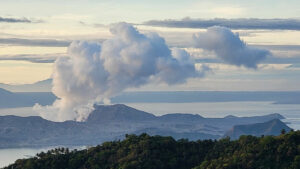PRESIDENT Ferdinand R. Marcos, Jr. on Thursday said authorities were monitoring the situation around Taal Volcano south of the capital after a minor eruption on Oct. 2.
The volcano had been silent after its phreatomagmatic eruption on Wednesday, according to Philippine Institute of Volcanology and Seismology.
It had not detected any quakes within 24 hours since it spewed a plume of steam that was more than 2 kilometers (1.24 miles) high.
“When the volcano erupts or the storm comes or if there’s an earthquake or whatever, they know what to do,” Mr. Marcos told reporters in Pasig City, referring to local authorities. “What we have to do is to monitor the situation and continue to see where are the areas, because not every situation is the same.”
Taal, located about 70 km south of Manila, is one of the world’s smallest active volcanoes, and some of its previous eruptions had affected the capital and air travel.
The agency’s chief Teresito Bacolcol on Wednesday described the eruption as phreatomagmatic, where magma interacts with water and produces a plume of steam. He added that there was no need for people to evacuate yet.
The volcano sits inside a large lake near the town of Tagaytay in Cavite province.
Mr. Bacolcol said the alert level remained at the lowest on the scale and there were no immediate reports of injuries.
Despite standing at only 311 meters (1,020 feet), it can be deadly and an eruption in 1911 killed more than 1,300 people.
In July 2021, thousands of people were evacuated after it spewed a kilometer-high plume of gas and steam.
A year earlier, Taal volcano shot a column of ash and steam as high as 15 km into the sky, forcing more than 100,000 people to abandon their homes and triggered widespread disruption in the capital.
The Philippines lies in the so-called Pacific Ring of Fire, a belt of volcanoes around the Pacific Ocean where most of the world’s earthquakes strike. I also lies along the typhoon belt in the Pacific and experiences about 20 storms each year. — KATA
